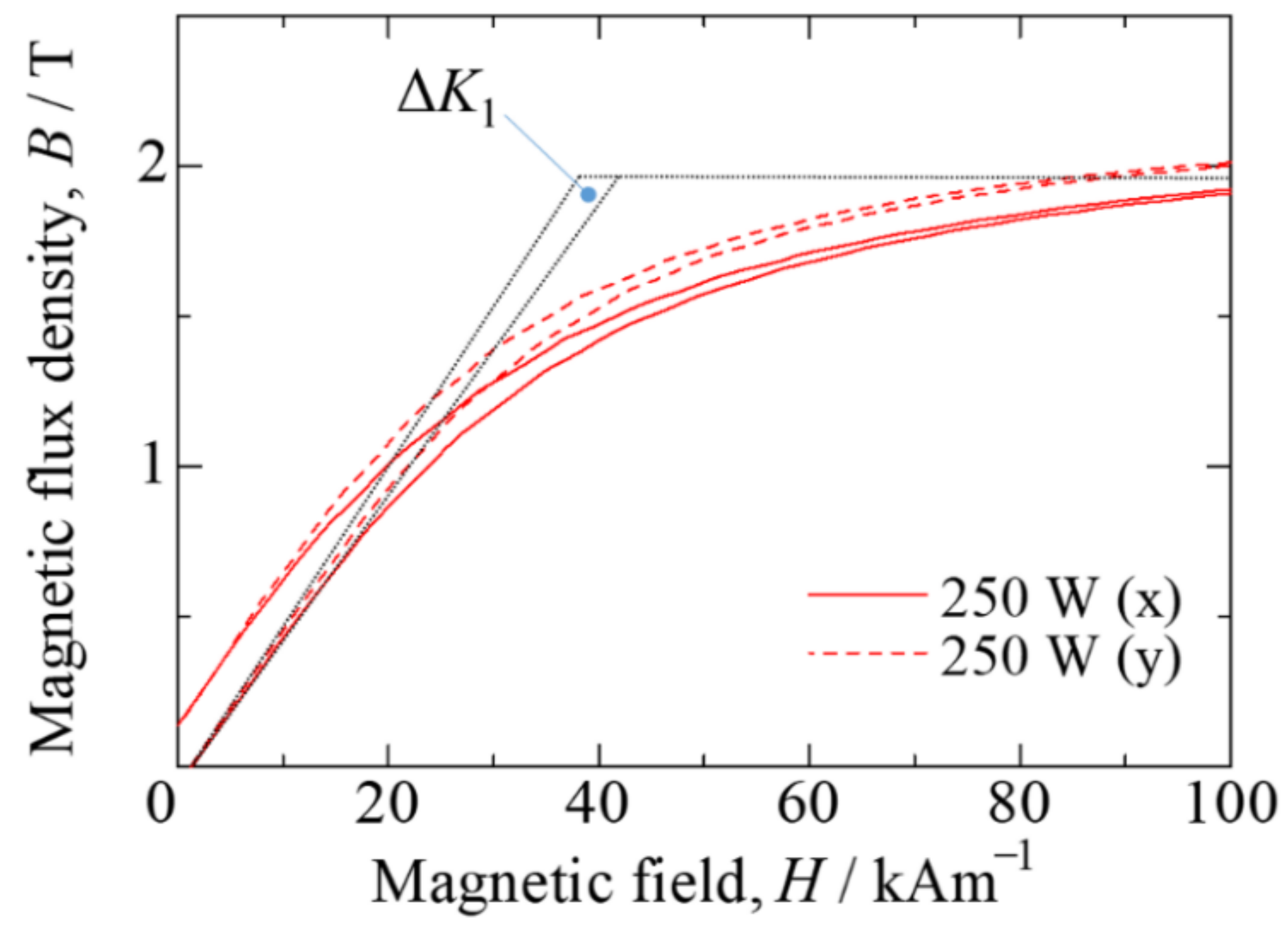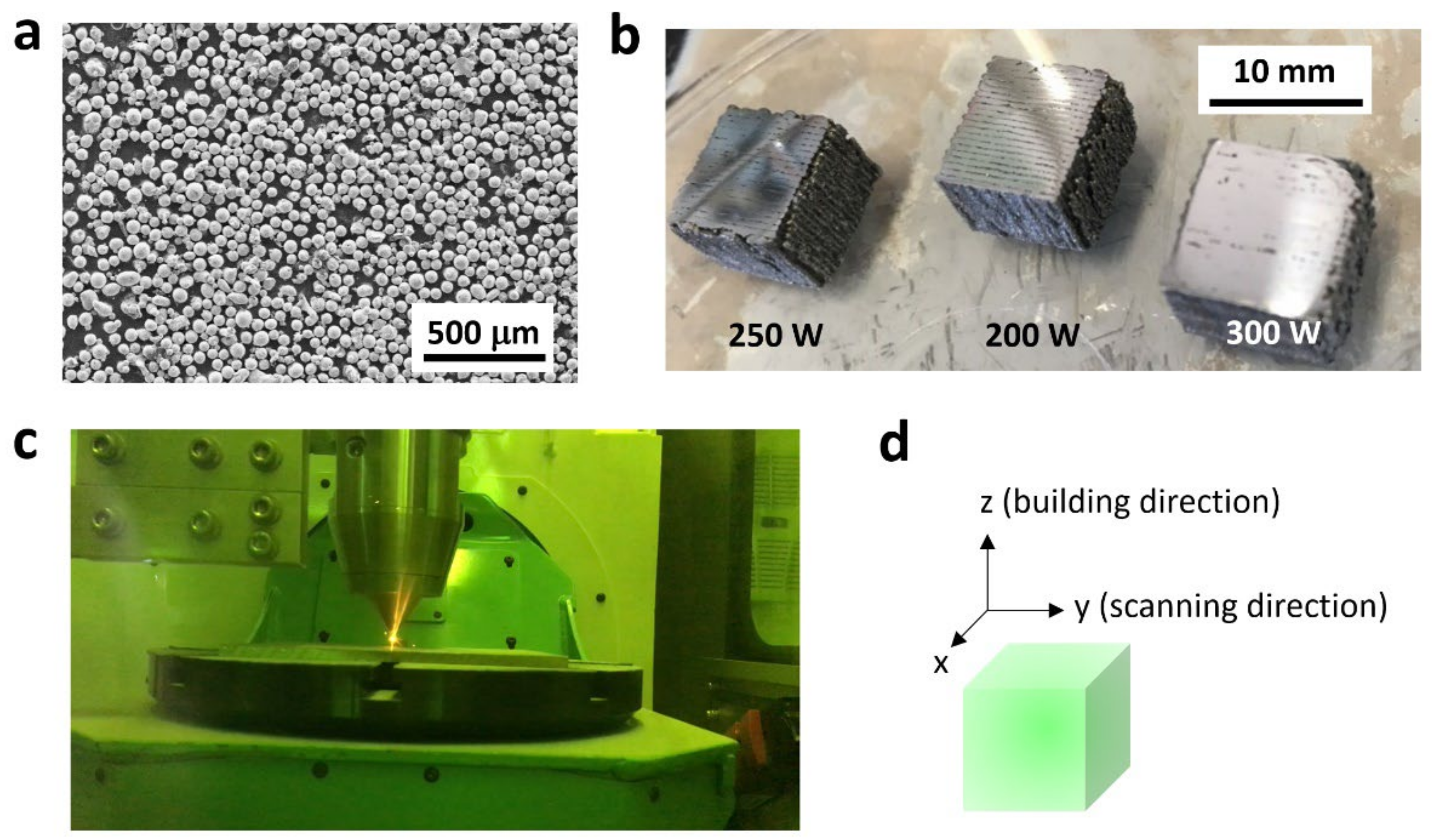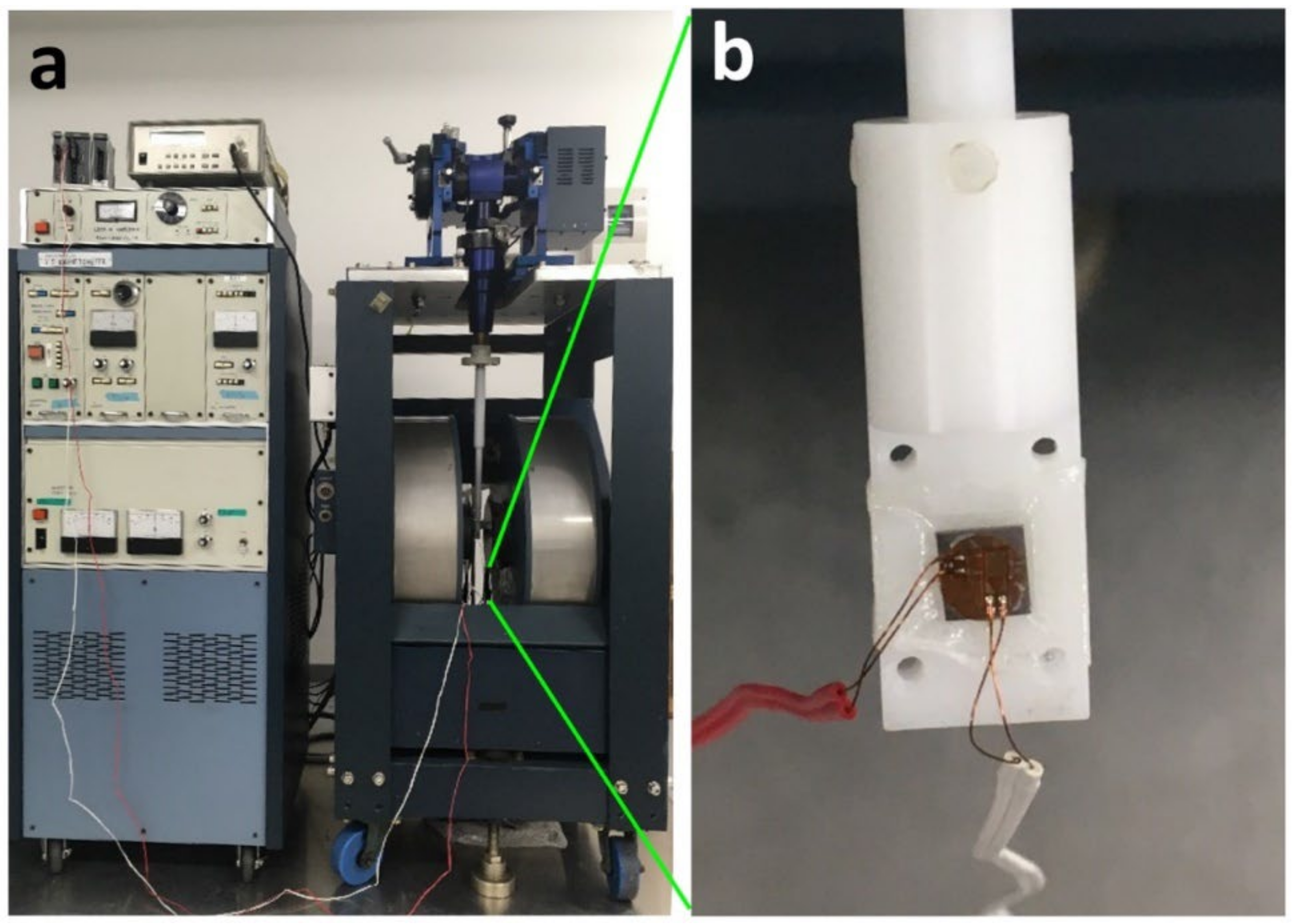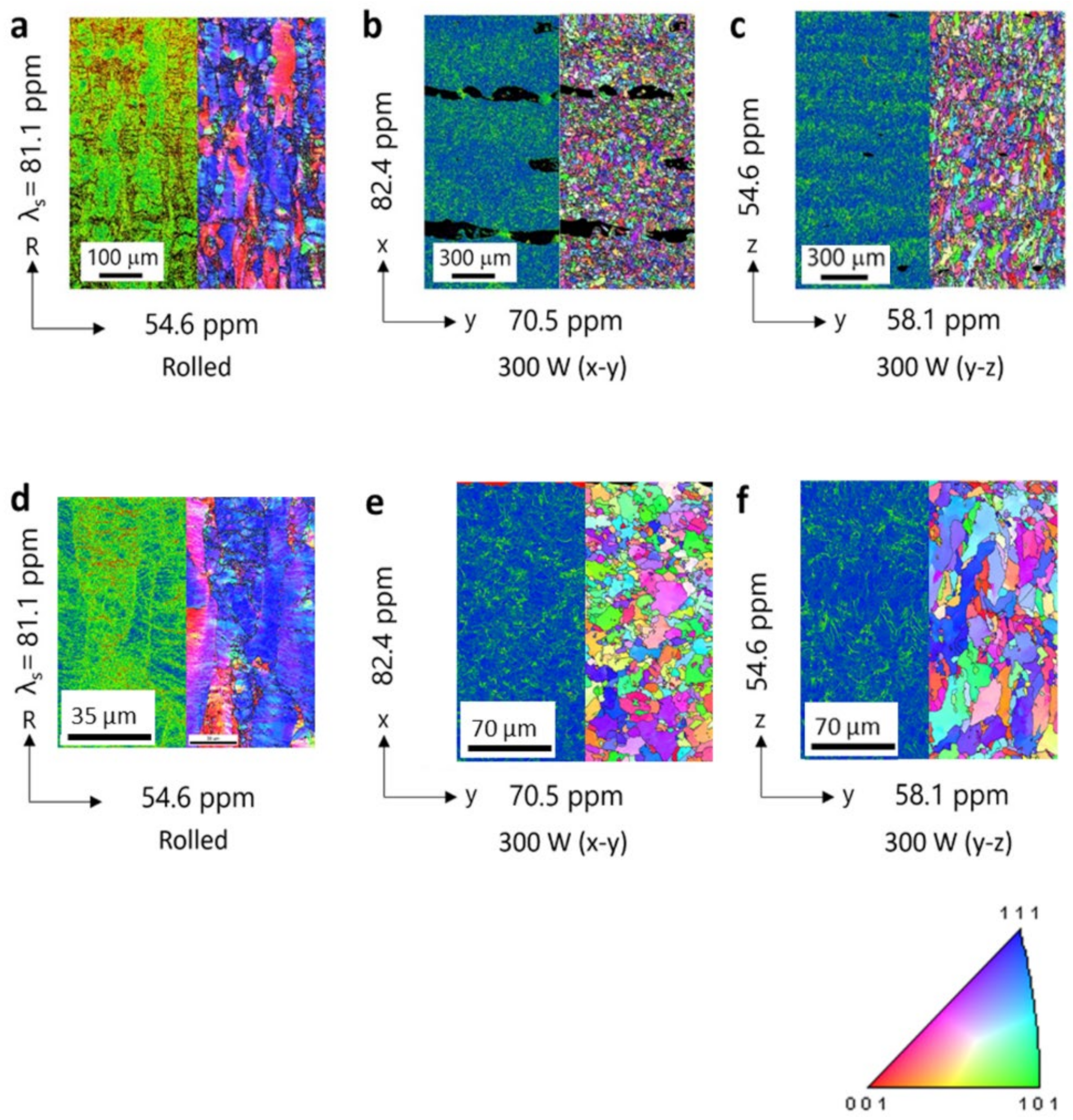Additive Manufacturing of Magnetostrictive Fe–Co Alloys
Abstract
:1. Introduction
2. Experimental Procedure
3. Results and Discussion
4. Conclusions
Author Contributions
Funding
Institutional Review Board Statement
Informed Consent Statement
Data Availability Statement
Conflicts of Interest
Appendix A
Appendix B

References
- Néel, L. Anisotropie magnétique superficielle et surstructures d’orientation. J. Phys. 1954, 15, 225–239. [Google Scholar] [CrossRef]
- Ren, S.; Xue, D.; Ji, Y.; Liu, X.; Yang, S.; Ren, X. Low-field-triggered large magnetostriction in iron-palladium strain glass alloys. Phys. Rev. Lett. 2017, 119, 125701. [Google Scholar] [CrossRef] [PubMed]
- Narita, F.; Fox, M. A review on piezoelectric, magnetostrictive, and magnetoelectric materials and device technologies for energy harvesting applications. Adv. Eng. Mater. 2018, 20, 1700743. [Google Scholar] [CrossRef] [Green Version]
- He, Y.; Ke, X.; Jiang, C.; Miao, N.; Wang, H.; Coey, J.M.D.; Wang, Y.; Xu, H. Interaction of trace rare-earth dopants and nanoheterogeneities induces giant magnetostriction in Fe-Ga alloys. Adv. Funct. Mater. 2018, 28, 1800858. [Google Scholar] [CrossRef]
- Bhatti, S.; Ma, C.; Liu, X.; Piramanayagam, S.N. Stress-induced domain motion in FeCo-based magnetic microwires for realization of energy harvesting. Adv. Electron. Mater. 2019, 5, 1800467. [Google Scholar] [CrossRef] [Green Version]
- Mahfouzi, F.; Carman, G.P.; Kioussis, N. Magnetoelastic and magnetostrictive properties of Co2XAl Heusler compounds. Phys. Rev. B 2020, 102, 094401. [Google Scholar] [CrossRef]
- Narita, F.; Wang, Z.; Kurita, H.; Li, Z.; Shi, Y.; Jia, Y.; Soutis, C. A review of piezoelectric and magnetostrictive biosensor materials for detection of COVID-19 and other viruses. Adv. Mater. 2021, 33, e2005448. [Google Scholar] [CrossRef]
- Clark, A.E.; Cullen, J.R.; Sato, K. Magnetostriction of single crystal and polycrystal rare earth-Fe2 compounds. AIP Conf. Proc. 1975, 24, 670–671. [Google Scholar]
- Na, S.-M.; Eng-Morris, J.; Downing, J.; Flatau, A.B. Crystal orientation dependence of magnetization and magnetostriction behaviors in highly textured Galfenol and Alfenol thin sheets. IEEE Trans. Magn. 2017, 53, 1. [Google Scholar] [CrossRef]
- Dong, M.; Liu, T.; Guo, X.; Xiao, Y.; Yuan, Y.; Wang, Q. Magnetostriction induced by crystallographic orientation and morphological alignment in a TbFe2-based alloy. J. Appl. Phys. 2019, 125, 033901. [Google Scholar] [CrossRef]
- Milyutin, V.A.; Gervasyeva, I.V.; Volkova, E.G.; Alexandrov, A.V.; Cheverikin, V.V.; Mansouri, Y.; Palacheva, V.V.; Golovin, I.S. Texture formation in FeGa alloy at cold hydrostatic extrusion and primary recrystallization. J. Alloys Compound. 2020, 816, 153283. [Google Scholar] [CrossRef]
- Mei, W.; Okane, T.; Umeda, S.; Zhou, T. Directional solidification of Tb-Dy-Fe magnetostrictive alloy. J. Alloys Compd. 1997, 248, 151–158. [Google Scholar] [CrossRef]
- Clark, A.E.; Restorff, J.B.; Wun-Fogle, M.; Lograsso, T.A.; Schlagel, D.L. Magnetostrictive properties of body–centered cubic. IEEE Trans. Magn. 2000, 36, 3238–3240. [Google Scholar] [CrossRef]
- Zhao, Y.; Mu, X.; Li, J.; Liu, Y.; Bao, X.; Gao, X.; Liu, J. Texture evolution and magnetostriction of rolled (Co70Fe30)99.8(NbC)0.2 sheets. IEEE Trans. Magn. 2019, 55, 1–5. [Google Scholar] [CrossRef]
- Hunter, D.; Osborn, W.; Wang, K.; Kazantseva, N.; Hattrick-Simpers, J.; Suchoski, R.; Takahashi, R.; Young, M.; Mehta, A.; Bendersky, L.A.; et al. Giant magnetostriction in annealed Co1−xFex thin-films. Nat. Commun. 2011, 2, 518. [Google Scholar] [CrossRef] [Green Version]
- Narita, F. Inverse magnetostrictive effect in Fe29Co71 wire/polymer composites. Adv. Eng. Mater. 2016, 19, 1600586. [Google Scholar] [CrossRef]
- Yang, Z.; Nakajima, K.; Onodera, R.; Tayama, T.; Chiba, D.; Narita, F. Magnetostrictive clad steel plates for high-performance vibration energy harvesting. Appl. Phys. Lett. 2018, 112, 073902. [Google Scholar] [CrossRef]
- Yang, Z.; Nakajima, K.; Jiang, L.; Kurita, H.; Murasawa, G.; Narita, F. Design, fabrication and evaluation of metal-matrix lightweight magnetostrictive fiber composites. Mater. Des. 2019, 175, 107803. [Google Scholar] [CrossRef]
- Wang, Z.; Mori, K.; Nakajima, K.; Narita, F. Fabrication, modeling and characterization of magnetostrictive short fiber composites. Materials 2020, 13, 1494. [Google Scholar] [CrossRef] [Green Version]
- Yang, Z.; Wang, Z.; Nakajima, K.; Neyama, D.; Narita, F. Structural design and performance evaluation of FeCo/epoxy magnetostrictive composites. Compos. Sci. Technol. 2021, 210, 108840. [Google Scholar] [CrossRef]
- Kenel, C.; Casati, N.P.M.; Dunand, D.C. 3D ink-extrusion additive manufacturing of CoCrFeNi high-entropy alloy micro-lattices. Nat. Commun. 2019, 10, 1–8. [Google Scholar] [CrossRef] [Green Version]
- Zhang, D.; Qiu, D.; Gibson, M.A.; Zheng, Y.; Fraser, H.L.; StJohn, D.H.; Easton, M.A. Additive manufacturing of ultrafine-grained high-strength titanium alloys. Nature 2019, 576, 91–95. [Google Scholar] [CrossRef]
- Han, C.; Fang, Q.; Shi, Y.; Tor, S.B.; Chua, C.K.; Zhou, K. Recent advances on high-entropy alloys for 3D printing. Adv. Mater. 2020, 32, e1903855. [Google Scholar] [CrossRef] [PubMed]
- Murakumo, T.; Kobayashi, T.; Koizumi, Y.; Harada, H. Creep behaviour of Ni-base single-crystal superalloys with various γ’ volume fraction. Acta Mater. 2004, 52, 3737–3744. [Google Scholar] [CrossRef]
- Dai, H.J.; D’Souza, N.; Dong, H.B. Grain selection in spiral selectors during investment casting of single-crystal turbine blades: Part I. experimental investigation. Met. Mater. Trans. A 2011, 42, 3430–3438. [Google Scholar] [CrossRef]
- Yuan, L.; Ding, S.; Wen, C. Additive manufacturing technology for porous metal implant applications and triple minimal surface structures: A review. Bioact. Mater. 2019, 4, 56–70. [Google Scholar] [CrossRef] [PubMed]
- Hunt, J. Steady state columnar and equiaxed growth of dendrites and eutectic. Mater. Sci. Eng. 1984, 65, 75–83. [Google Scholar] [CrossRef]
- Sun, S.-H.; Koizumi, Y.; Kurosu, S.; Li, Y.; Matsumoto, H.; Chiba, A. Build direction dependence of microstructure and high-temperature tensile property of Co–Cr–Mo alloy fabricated by electron beam melting. Acta Mater. 2014, 64, 154–168. [Google Scholar] [CrossRef]
- Ishimoto, T.; Hagihara, K.; Hisamoto, K.; Sun, S.H.; Nakano, T. Crystallographic texture control of beta-type Ti–15Mo–5Zr–3Al alloy by selective laser melting for the development of novel implants with a biocompatible low Young’s modulus. Sci. Mater. 2017, 132, 34–38. [Google Scholar] [CrossRef]
- Wei, H.L.; Mazumder, J.; DebRoy, T. Evolution of solidification texture during additive manufacturing. Sci. Rep. 2015, 5, 16446. [Google Scholar] [CrossRef] [Green Version]
- Gäumann, M.; Bezençon, C.; Canalis, P.; Kurz, W. Single-crystal laser deposition of superalloys: Processing–microstructure maps. Acta Mater. 2001, 49, 1051–1062. [Google Scholar] [CrossRef]
- Kaierle, S.; Overmeyer, L.; Alfred, I.; Rottwinkel, B.; Hermsdorf, J.; Wesling, V.; Weidlich, N. Single-crystal turbine blade tip repair by laser cladding and remelting. CIRP J. Manuf. Sci. Technol. 2017, 19, 196–199. [Google Scholar] [CrossRef]
- Carroll, B.E.; Otis, R.A.; Borgonia, J.P.; Suh, J.; Dillon, R.P.; Shapiro, A.A.; Hofmann, D.C.; Liu, Z.; Beese, A.M. Functionally graded material of 304L stainless steel and inconel 625 fabricated by directed energy deposition: Characterization and thermodynamic mod-eling. Acta. Mater. 2016, 108, 46–54. [Google Scholar] [CrossRef] [Green Version]
- Nakajima, K.; Kurita, H.; Narita, F. Performance boost of co-rich fe-co based alloy magnetostrictive sensors via nitrogen treatment. Sens. Actuators A Phys. 2019, 295, 75–83. [Google Scholar] [CrossRef]
- Han, Y.; Wang, H.; Zhang, T.; He, Y.; Coey, J.; Jiang, C. Tailoring the heterogeneous magnetostriction in Fe-Co alloys. J. Alloy. Compd. 2017, 699, 200–209. [Google Scholar] [CrossRef]
- Okamoto, H. Co-Fe (Cobalt-Iron). J. Phase Equilibria Diffus. 2008, 29, 383–384. [Google Scholar] [CrossRef]
- Lanfant, B.; Bär, F.; Mohanta, A.; Leparoux, M. Fabrication of metal matrix composite by laser metal deposition—a new process approach by direct dry injection of nanopowders. Materials 2019, 12, 3584. [Google Scholar] [CrossRef] [Green Version]
- Cui, D.; Mohanta, A.; Leparoux, M. Interface control in additive manufacturing of dissimilar metals forming intermetallic compounds—Fe-Ti as a model system. Materials 2020, 13, 4747. [Google Scholar] [CrossRef]
- Thijs, L.; Verhaeghe, F.; Craeghs, T.; Humbeeck, J.V.; Kruth, J.P. A study of the microstructural evolution during selective laser melting of Ti–6Al–4V. Acta Mater. 2010, 58, 3303–3312. [Google Scholar] [CrossRef]
- Gong, H.; Rafi, K.; Gu, H.; Starr, T.; Stucker, B. Analysis of defect generation in Ti–6Al–4V parts made using powder bedfusion additive manufacturing processes. Addit. Manuf. 2014, 1–4, 87–98. [Google Scholar]
- Wan, Y.; Fang, D.; Hwang, K.-C. Non-linear constitutive relations for magnetostrictive materials. Int. J. Non-Linear Mech. 2003, 38, 1053–1065. [Google Scholar] [CrossRef]
- Jia, Z.; Liu, W.; Zhang, Y.; Wang, F.; Guo, D. A nonlinear magnetomechanical coupling model of giant magnetostrictive thin films at low magnetic fields. Sens. Actuators A Phys. 2006, 128, 158–164. [Google Scholar] [CrossRef]
- Han, Y.; Wang, H.; Zhang, T.; He, Y.; Jiang, C. Giant magnetostriction in nanoheterogeneous Fe-Al alloys. Appl. Phys. Lett. 2018, 112, 082402. [Google Scholar] [CrossRef] [Green Version]
- Szumiata, T.; Gzik-Szumiata, M.; Brzózka, K.; Górka, B.; Gawroński, M.; Finkel, A.C.; Reeves-McLaren, N.; Morley, N.A. Interface influence on the properties of Co90Fe10 films on soft magnetic underlayers—magnetostrictive and mössbauer spectrometry studies. J. Magn. Magn. Mater. 2016, 401, 943–948. [Google Scholar] [CrossRef]
- Yanai, T.; Mieda, K.; Kaji, J.; Tanaka, R.; Yamashita, A.; Morimura, T.; Nakano, M.; Fukunaga, H. Electroplated Fe-Co films prepared in citric-acid-based plating baths with saccharin and sodium lauryl sulfate. AIP Adv. 2020, 10, 055001. [Google Scholar] [CrossRef]





| Ball size | ⌀10 mm |
| Ball weight before milling | 1200 g |
| Weight of first powder | 135 g |
| Process control agent (PCA) | 135% |
| Milling gas | Argon 4.8 (99.998%) |
| Milling cycles | 9 |
| Speed | 350 rpm |
| Interval | 10 min |
| Break | 10 min |
| Direction of rotation | Up-milling |
| Milling process time | 3 h |
| Laser Power (W) | Energy Density (J/mm3) | Density (g/cm3) | Error (%) |
|---|---|---|---|
| 200 | 107.1 | 7.60 | 10.9 |
| 250 | 133.9 | 7.72 | 9.5 |
| 300 | 160.7 | 7.85 | 8.0 |
| Sample | Plane | Direction | Saturation Magnetization (T) | Remanent Magnetization (T) | Coercivity (kA/m) |
|---|---|---|---|---|---|
| Rolled | - | R// | 2.26 | 0.20 | 5.40 |
| R⊥ | 2.30 | 0.22 | 5.07 | ||
| 300 W | x–y | x | 2.02 | 0.12 | 3.32 |
| y | 1.97 | 0.15 | 3.12 | ||
| y–z | y | 1.42 | 0.11 | 3.09 | |
| z | 1.42 | 0.13 | 3.08 | ||
| z–x | z | 2.01 | 0.13 | 2.96 | |
| x | 2.02 | 0.12 | 3.15 |
Publisher’s Note: MDPI stays neutral with regard to jurisdictional claims in published maps and institutional affiliations. |
© 2022 by the authors. Licensee MDPI, Basel, Switzerland. This article is an open access article distributed under the terms and conditions of the Creative Commons Attribution (CC BY) license (https://creativecommons.org/licenses/by/4.0/).
Share and Cite
Nakajima, K.; Leparoux, M.; Kurita, H.; Lanfant, B.; Cui, D.; Watanabe, M.; Sato, T.; Narita, F. Additive Manufacturing of Magnetostrictive Fe–Co Alloys. Materials 2022, 15, 709. https://doi.org/10.3390/ma15030709
Nakajima K, Leparoux M, Kurita H, Lanfant B, Cui D, Watanabe M, Sato T, Narita F. Additive Manufacturing of Magnetostrictive Fe–Co Alloys. Materials. 2022; 15(3):709. https://doi.org/10.3390/ma15030709
Chicago/Turabian StyleNakajima, Kenya, Marc Leparoux, Hiroki Kurita, Briac Lanfant, Di Cui, Masahito Watanabe, Takenobu Sato, and Fumio Narita. 2022. "Additive Manufacturing of Magnetostrictive Fe–Co Alloys" Materials 15, no. 3: 709. https://doi.org/10.3390/ma15030709








